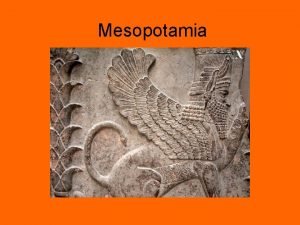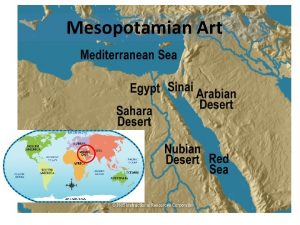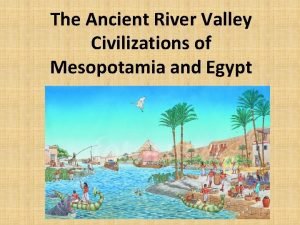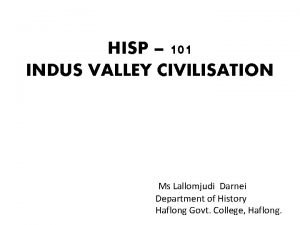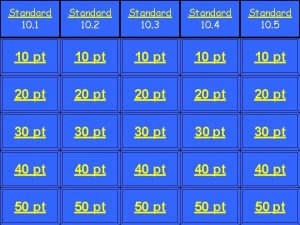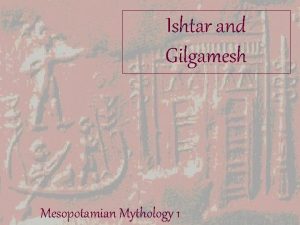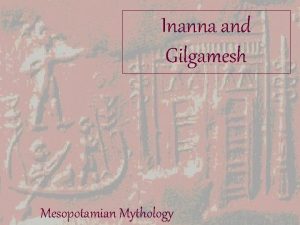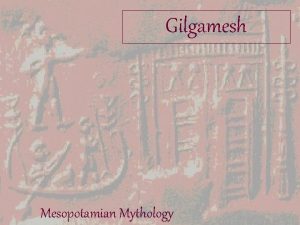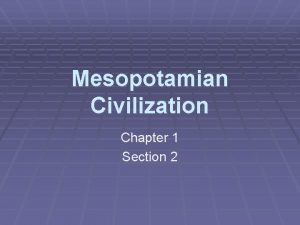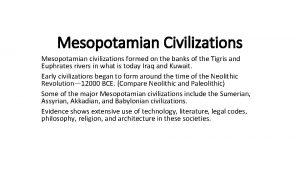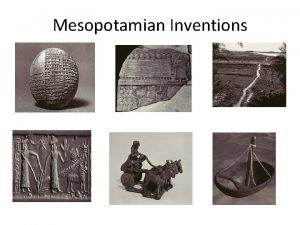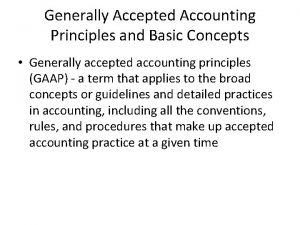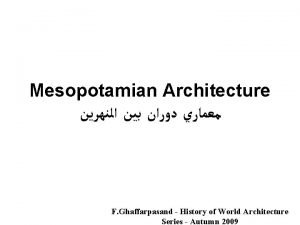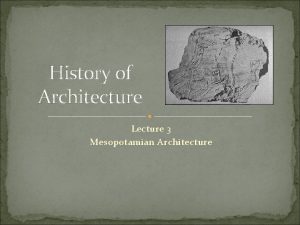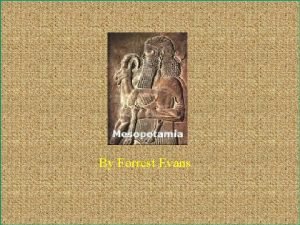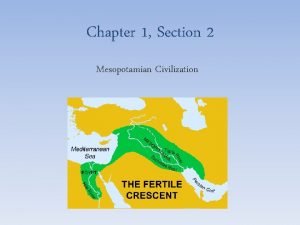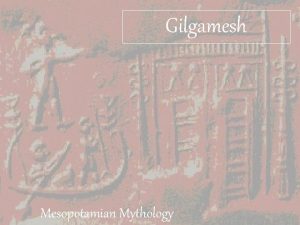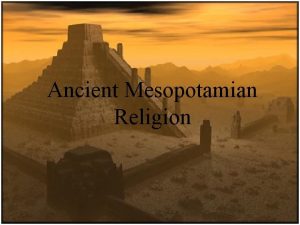Mesopotamian Architecture Mesopotamian Architecture Introduction It is generally


































- Slides: 34

Mesopotamian Architecture

Mesopotamian Architecture – Introduction • It is generally accepted that Mesopotamia is the cradle of civilization; cradle and tomb of nations and empires • Mesos= middle • Patamos= river • Mesos + Patamos = between the rivers (Tigris and Euphrates) • Middle Eastern civilization • Prehistory to the 6 th century b. c.

Mesopotamian Architecture – Introduction • Mesopotamia, located in a region that included parts of what is now eastern Syria, south-eastern Turkey, and most of Iraq, lay between two rivers, the Tigris and the Euphrates

Mesopotamian Architecture – Introduction

Mesopotamian Architecture – Basic Materials • • most fertile land on earth; the ‘fertile crescent’ network of irrigation channels Alluvial district of thick mud clay – mud brick Walls were faced with burnt bricks and glazed bricks of different colors • Stone was rare but imported – basalt, sandstone • Metals – fine sculpture

General Architecture • • • Massive towered fortifications Earliest – temple (commercial and religious) Later - palace Temples Palaces – Assyrian/ Persian • Buildings raised on huge platforms due to torrential rain and frequent flood • Bitumen, pitch, mortar of calcareous earth (slime) - used as cementing material • Buildings of all types arranged round large and small courts • Rooms were narrow, long, rectangular form and thick walled carrying brick barrel vaults or domes

Mesopotamian Architecture • • • Chief temples had sacred ziggurats (artificial mountains made of tiered rectangular stages (1 to 7) Burnt bricks used for facings White washed walls Ziggurat – colour painted Arcuated architectural style (true arch with radiating voussoirs)

Historical periods Early civilization flourished here: 1. Sumerian - Ur of the Chaldees BC 4000 – 1275

Historical periods • 2. Assyrian (1275 – 538) • Cities include – Nimrud, Khorsabad and Nineveh • Kings: • Ashur-nasir-pal (885 -860) • Sargon (722 -705) • Senna. Cherib (705681) • Esharhaadon • Asur-beni-pal

Historical periods • 3. Persian Period (BC 538333) • Susa, Perspolis, • Cyrus, Darius, Xerxes • Alexander the great – W. Asia became a Greek province

Early Mesopotamian (Sumerian) Ziggurats

Early Mesopotamian (Sumerian) Ziggurats • • Temple tower Terraced pyramid with successive receding stories Sumerians, Babylonians, Assyrians Top of the ziggurat is flat Core – sun baked bricks Facing – fired bricks Facing – glazed in different colours

Early Mesopotamian (Sumerian) Ziggurats- Ziggurat of Urnammu, Ur • • • Located in the centre of villages 1 -7 tiers Ziggurat (205 x 141 ft) base Shrine or temple at the summit above 70’ Access to the shrine – Series of ramps on one side of the ziggurat – Spiral ramp • No internal chambers Not for public worship or ceremonies • Only for priests • Dwelling place for gods • Core – sun baked bricks • 8’ thick skin of burnt brick and bitumen

Assyrian Architecture

Assyrian • Polychrome ornamental glazed brickwork • Use of high plinths carved with low relief sculpture • Temples with and without ziggurats • Palaces – numerous • City of Nimrud • City of Khorsabad • City of Nineveh

Assyrian – City of Khorsabad • Khorsabad (BC 722 – 705) • Excavated in AD 864 – provides the best idea of Assyrian Palaces • Built by Sargon II • Square planned with a defensive perimeter • 1 sq. mile • Palace for the king’s brother, temple, official buildings, Palace of Sargon

Assyrian – City of Khorsabad – Palace of Sargon • Complex of large and small courts • Corridors and rooms • 23 acres • Raised upon a terrace – 15 m high • a platform of sun dried brick faced with stone • 700 rooms (300 x 400 m) • Approached by broad ramps

Assyrian – City of Khorsabad – Palace of Sargon • Main entrance to the palace grand court flanked by great towers and guarded by man headed winged bulls (12’ 6”high) • This bull supports a semicircular arch • Decorated with brilliantly coloured glazed bricks

Assyrian – City of Khorsabad – Palace of Sargon Private and residential apartments • Palaces had 3 main parts – each abutting the grand court • Left – 6 temples (3 small and 3 big) ziggurat • Right – service quarters and administrative houses • Opposite – private and the residential apartments temples Service quarters and administrative houses

Assyrian – City of Khorsabad – Palace of Sargon • Around the state court – dado slabs (7’ high) – reliefs of the king and his courtiers • Flat timber ceiling for the apartments • Winding ramped ziggurat associated with palace temples (148’ side)

Assyrian – City of Khorsabad – Palace of Sargon

Persian Architecture

Persian Architecture – Palace of Persepolis • 518 b. c. • By Darius I, Xerxes I, Artaxerxes I • On a platform faced with local stone

Persian Architecture – Palace of Persepolis • 1500 x 900 ft • Rising 50’ above the plain • 22’ wide steps on the NW side • Shallow enough for the horses to ascend • had mud brick walls faced with polychrome bricks • Front and rear portals guarded by stone bulls

Persian Architecture – Palace of Persepolis Throne room Apadana Tripylon Palace of Darius Palace of Xerxes Harem Treasury

Persian Architecture – Palace of Persepolis

Persian Architecture – Palace of Persepolis

Persian Architecture – Palace of Persepolis • Apadana • A grand audience hall • On its own terrace 10’ high • 250’ square • With 36 columns

Persian Architecture – Palace of Persepolis • Apadana

Persian Architecture – Palace of Persepolis • Tripylon • terraced • Lay centrally among the buildings • Acts as a reception chamber and guard room for the more private quarters of the palace group

Persian Architecture – Palace of Persepolis • Treasury • SE angle of the site • Double walled administrative and store house building • With columned halls of different sizes • Only a single doorway

Persian Architecture – Palace of Persepolis • Palace of Xerxes and Harem • Near the SW angle of the site • Connects with an Lshaped building (harem) • Harem – Women’s quarters

Persian Architecture – Palace of Persepolis • Throne Room - Hall of 100 columns • • Throne Hall 225’ square Flat cedar roof Portico faced a forecourt

Persian Architecture – Palace of Persepolis – Hall of Hundred Columns
 Conclusion of the mesopotamian civilization
Conclusion of the mesopotamian civilization Introduction to mesopotamian civilization
Introduction to mesopotamian civilization Introduction about harappan civilization
Introduction about harappan civilization Mesopotamian art characteristics
Mesopotamian art characteristics Mesopotamian society
Mesopotamian society Conclusion of mesopotamian civilization
Conclusion of mesopotamian civilization Conclusion of mesopotamian civilization
Conclusion of mesopotamian civilization Conclusion of mesopotamian civilization
Conclusion of mesopotamian civilization What happens when the temperature of the air cools brainpop
What happens when the temperature of the air cools brainpop Sound waves from a radio generally travel in which medium
Sound waves from a radio generally travel in which medium Prep phrases
Prep phrases In a minimum cardinality, minimums are generally stated as
In a minimum cardinality, minimums are generally stated as Why is learning relatively permanent
Why is learning relatively permanent Alicia has started a new and very different job
Alicia has started a new and very different job When to use comma before because
When to use comma before because Chaparral biomes are generally _______.
Chaparral biomes are generally _______. Clarity is the soul of business letter true or false
Clarity is the soul of business letter true or false An access matrix is generally dense.
An access matrix is generally dense. The steps in draping and shampooing
The steps in draping and shampooing Finance companies generally:
Finance companies generally: Culture that generally pursued by the upper class
Culture that generally pursued by the upper class An element that can add interest and reality to artwork
An element that can add interest and reality to artwork Generally restful like the horizon
Generally restful like the horizon Shapes that have smooth even edges and are measurable
Shapes that have smooth even edges and are measurable Generally, people use facial management techniques to
Generally, people use facial management techniques to Divine feminine energy
Divine feminine energy Arti gaap
Arti gaap It is generally refers to human movement
It is generally refers to human movement Chapter 58 coronal polishing
Chapter 58 coronal polishing At the end of the 1800s colonies were generally seen as a
At the end of the 1800s colonies were generally seen as a Delayed differentiation and modular design
Delayed differentiation and modular design What is the scenario the ide generally required?
What is the scenario the ide generally required? Scientifically minded people generally
Scientifically minded people generally Unit dose dispensing definition
Unit dose dispensing definition Milady chapter 16 review questions
Milady chapter 16 review questions

